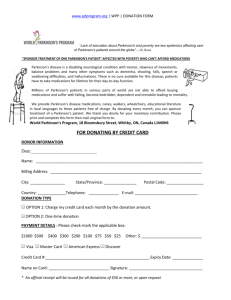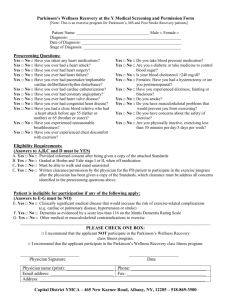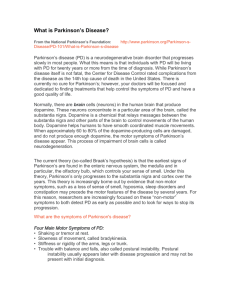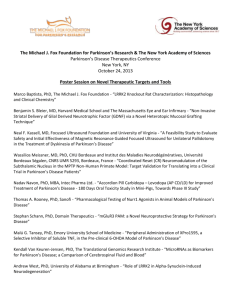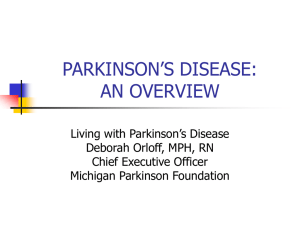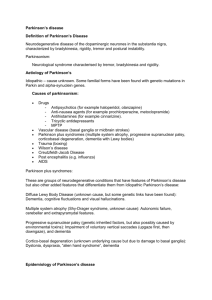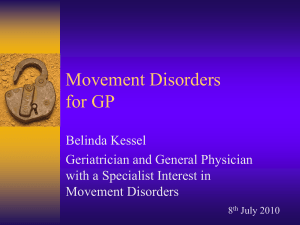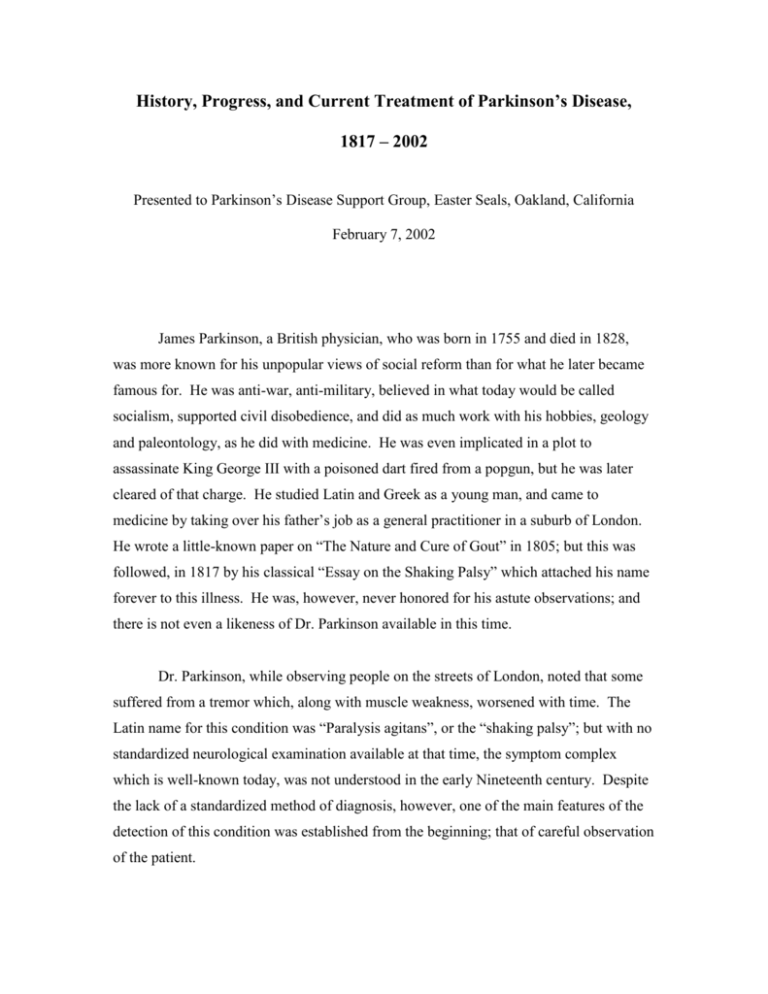
History, Progress, and Current Treatment of Parkinson’s Disease,
1817 – 2002
Presented to Parkinson’s Disease Support Group, Easter Seals, Oakland, California
February 7, 2002
James Parkinson, a British physician, who was born in 1755 and died in 1828,
was more known for his unpopular views of social reform than for what he later became
famous for. He was anti-war, anti-military, believed in what today would be called
socialism, supported civil disobedience, and did as much work with his hobbies, geology
and paleontology, as he did with medicine. He was even implicated in a plot to
assassinate King George III with a poisoned dart fired from a popgun, but he was later
cleared of that charge. He studied Latin and Greek as a young man, and came to
medicine by taking over his father’s job as a general practitioner in a suburb of London.
He wrote a little-known paper on “The Nature and Cure of Gout” in 1805; but this was
followed, in 1817 by his classical “Essay on the Shaking Palsy” which attached his name
forever to this illness. He was, however, never honored for his astute observations; and
there is not even a likeness of Dr. Parkinson available in this time.
Dr. Parkinson, while observing people on the streets of London, noted that some
suffered from a tremor which, along with muscle weakness, worsened with time. The
Latin name for this condition was “Paralysis agitans”, or the “shaking palsy”; but with no
standardized neurological examination available at that time, the symptom complex
which is well-known today, was not understood in the early Nineteenth century. Despite
the lack of a standardized method of diagnosis, however, one of the main features of the
detection of this condition was established from the beginning; that of careful observation
of the patient.
2
It was not until the very late portion of the Nineteenth century that physicians
began to understand the anatomy and physiology of the nervous system. Pioneering work
by such greats in anatomy and physiology as Ramon y Cajal (from Spain) and
Sherrington (Britain) began to show us the fine anatomy of the brain; and when studies
were made of the brains of those patients who had died with the “Shaking Palsy”, now
named Parkinson’s Disease after the man who first described the external symptoms, it
was learned that certain areas of the brain seemed to be affected. These areas, including
such structures as the substantia nigra (so named because the tissue is black with
pigment), globus pallidus, parts of the thalamus, were all joined together in a generic
description as the “basal ganglia”, or collections of nerve cells at the base of the brain.
When we talk about the basal ganglia, we are talking about these multiple areas, many of
which play a role in other illnesses as well which are different from Parkinson’s Disease,
but are also associated with similar symptoms.
As knowledge grew and the physiology of the nervous system began to be
understood, it became apparent that Parkinson’s disease was a disease of both muscle
weakness and abnormal movement. The tremor of Parkinson’s disease is described as a
typical “pill-rolling” tremor, low in frequency (about 4-5 cycles per second); and is a
“tremor at rest”, meaning that it is most pronounced when the patient is not making a
voluntary movement, and it tends to decrease or even disappear with voluntary
movement. Years ago, when I first moved to Berkeley, I had a dentist who had early
Parkinson’s disease and who, when he was talking to me, had a mild tremor. One would
think that I might have been concerned at his ability to do dental surgery on me; but I was
confident that, once he began to engage in voluntary muscle activity, his hands would
become steady; and I remained with that dentist for some years until he retired. And I
still have my teeth, too!
Early on, too, it was found that patients with Parkinson’s disease, as the illness
progressed, developed a slowness of muscle function, and an associated rigidity of the
voluntary muscles, which, when the muscles were passively moved through their range of
motion, were felt as having “cogwheeling”, a grinding sensation to the examiner as the
3
rigidity and the tremor combined. Further, it was noted that the increasing rigidity
eventually affected the facial muscles, causing a rather drawn and monotonous facial
expression, which has been named the “Parkinsonian mask”; and that the increasing
tightness of the lower extremity muscles resulted in a characteristic propulsive gait where
the patient who have difficulty starting to walk, but once started, would walk with small
steps in a rapid and sometimes increasingly uncontrolled pace, called a “festinating gait”;
or as the French called it, “Marche a petit pieds” (“walking with little feet”)
Finally, it was noted that, along with the slowness of movement (“bradykinesia”),
came a tendency towards a slowing down of intellectual function, and that this, in time,
led to dementia which, in the later stages of the illness, could be quite crippling. Death
associated with Parkinson’s disease usually was not as a direct result of the illness, but
rather of the decreasing levels of activity of the patient brought on by the disease, and
eventual development of pneumonia or other conditions associated with inactivity. Thus,
to this day, maintenance of as active life as is possible is one of the ways to prolong life
in patients with Parkinson’s disease.
The cause of Parkinson’s disease is still not known. There are certain forms of
Parkinson’s disease that have been associated with such things as viral infection of the
central nervous system. The 1918 Influenza Pandemic, which killed more people than
did the Black Death in Medieval Europe, produced many cases of Parkinson-like disease
due to the encephalitis associated with the Influenza virus, and this form of the illness,
called “Post-encephalitic Parkinsonism” frequently affects only one side of the body,
whereas the traditional form of Parkinson’s disease is usually bilateral.
There are other associations of conditions with a Parkinsonian-like syndrome,
including certain toxic exposures such as carbon disulfide, carbon monoxide, and a
chemical named MPTP, sometimes used as a “recreational drug”. Additional causes
include other degenerative neurological diseases, including Alzheimer’s disease;
Huntington’s disease; side-effects from certain psychiatric drugs such as medications in
the Thorazine/Haldol family; and acute or chronic head injury problems. A condition
4
called “normal pressure hydrocephalus”, a variant of degenerative brain disease, may also
produce Parkinsonian-like symptoms. The management of these “Parkinsonian-type”
conditions is, however, different from the management of the typical case of Parkinson’s
disease, and I will limit my presentation today to the “traditional” Parkinson’s disease. I
will, however, be happy to answer questions concerning the other types at the end of this
talk.
The early diagnosis of Parkinson’s disease is difficult and subtle. Frequently, the
first sign is that of decreased movement, and there is a great story about two famous
British neurologists (with famous names that you will chuckle over) concerning the early
diagnosis of Parkinson’s. Sir Henry Head, a pioneer in British neurology, had a habit of
shaking his leg while he sat in an auditorium listening to a lecture; and one day, Russell
Brain (later given the title of “Lord Brain”), noted that Sir Henry was not shaking his leg
anymore. Brain said that he thought that Sir Henry Head was showing the early signs of
Parkinson’s disease, and he turned out to be quite correct. In the case of my own fatherin-law, also a physician, he came to stay with me while recovering from surgery
associated with a bad fall which he had taken at home; and, as I had the chance to
observe him constantly, it rapidly became apparent that he had early Parkinson’s disease;
and, in fact, that was probably the cause of his fall. After proper medication, he did well
for many years before passing away a few years ago at the age of 91.
When Parkinson’s disease is suspected, a good neurological evaluation is
mandatory. This is so that the other causes of similar symptoms can be explored, as the
treatments for those conditions are often very different that those used for Parkinson’s
disease of the “traditional” type. Such an evaluation should include a careful history and
neurological examination; imaging studies, beginning with at least, a CT scan of the
brain; and, if there is evidence of enlargement of the spinal fluid pathways, followed by a
radioisotope study called a “cisternogram” involving injection of a tracer into the spinal
fluid and several days of scanning thereafter to look for “normal pressure
hydrocephalus”. Although there are physicians who consider themselves “movement
5
disorder specialists”, I believe that a well-trained neurologist or neurosurgeon should be
able to complete a proper evaluation of a patient for Parkinson’s disease.
Treatment
In the years after the disease was described by Parkinson, there was very little that
could be done to alleviate the symptoms. It was, however, noted early on, that advanced
Parkinson’s disease was characterized by excessive drooling; and so, drugs, called
“anticholinergics”, which dry up mouth secretions, were tried as a treatment.
Surprisingly, these treatments seemed to help in many cases to reduce the drooling, and
also were found to decrease the tremor as well. We now know that this occurred because
of the effect of these drugs in blocking the abnormal nerve transmissions which go along
with Parkinson’s disease; and anticholinergics, such as Artane® and Cogentin®, are still
used early on in Parkinson’s disease, especially in those cases where tremor is a
predominant symptom.
The other thing which was noted early in the history of the knowledge of this
disease, was that if a patient with Parkinson’s disease had a stroke, the side affected by
the stroke would show improvement in, or even disappearance of the Parkinsonian
tremor. This led to the next breakthrough in the treatment of Parkinson’s when surgical
procedures were tried to interrupt the voluntary motor pathways of the brain in order to
alleviate tremor, and, to a lesser extent rigidity. These procedures, however, offered a
“trade-off”; a partial paralysis in return for a decrease in tremor, and were certainly not a
definitive answer.
One day, in the early sixties, Dr. Irving Cooper, a New York neurosurgeon, was
performing such an operation, when he inadvertently tore a small artery which supplied a
portion of the basal ganglia. He aborted the operation because of this; and, to his pleasant
surprise, when the patient awoke from the anesthetic, his tremor was gone and he did not
have the partial paralysis that the originally-planned operation would have produced. Dr.
Cooper then went about studies to determine what had happened, and he discovered that
6
the injury to the artery had caused the death of a small area of tissue within the globus
pallidus; and Dr. Cooper then went about experiments where the globus pallidus and
other parts of the basal ganglia were attacked. These areas included, in addition to the
globus pallidus, portions of the thalamus, putamen, subthalamus, and others; and the
means of producing the lesions have varied from chemicals (alcohol was used by Dr.
Cooper), to radioactive implants (we used a strontium-90 needle at the University of
Chicago where I trained in the sixties), to freezing, to heating with radiofrequency
current; but the main object was the same, to interrupt what was felt to be an “abnormal
circuit” between parts of the basal ganglia.
In the mid-sixties, Dr. Nicholas Cotzias and his associates discovered the
relationship between the natural neurotransmitter Dopamine and the cause of Parkinson’s
disease; and his group devised a way to get a precursor of Dopamine into the brain by
synthesizing the chemical L-DOPA. The results of this new treatment were dramatic;
and this was followed by almost overnight abandonment of the surgical procedures which
had been developed in the early sixties, which, although they were effective, did not seem
to be permanent, and many of the patients who were initially improved after surgery on
the basal ganglia relapsed after several years.
Sadly, however, it was subsequently determined that the use of L-DOPA, while
dramatic initially, was limited by a problem of growing tolerance to the beneficial effects
of the medicine, this resulting in the need to increase the dose over time, and eventually
making the side-effects worse than the beneficial effects. Thus, excessive dosage with LDOPA or its relatives could lead to worsening of the abnormal movements
(“dyskinesias”), gastrointestinal symptoms, insomnia, hallucinations, and even psychosis,
while the beneficial effects would decrease with time.
Some agents, called “neuroprotective agents” were likewise developed, the most
common being Selegiline (Deprenyl® or Eldepryl®), which have been added to antiParkinson regimens to try and delay the need for use of high doses of L-DOPA; but the
results of the use of such drugs, while seemingly beneficial early on, are not totally clear.
7
Because of the problems associated with L-DOPA, in the eighties and nineties,
the surgical approach was once again investigated. Dr. Lauri Laitinen, a neurosurgeon
working in Sweden, refined some of the old basal ganglion procedures, and developed a
somewhat more precise and elegant method of placing destructive lesions in the globus
pallidus and elsewhere. When the globus pallidus was lesioned, the procedure was called
“pallidotomy”; and some investigators found that pallidotomy had some benefit in
reducing the amount of L-DOPA needed to control the symptoms, as well as the fact that
it seemed to improve the physical “slowness” associated with the rigidity. Pallidotomy,
however, did not seem to help the dementia very much, and, as the procedural indications
were developed, demented patients were usually excluded from those who were offered
pallidotomy. Lesions placed in the thalamus, called thalamotomy, seemed to have
positive effects on tremor, but did little for rigidity or “slowness”. There was a strong
flurry of basal ganglion surgery in the nineties with many centers and even privatelypracticing neurosurgeons offering pallidotomy, but, as was predicted by others, the
results have not lived up to hopes for these procedures, and they, essentially destructive
operations, are once again losing favor.
During the last few years, some new and exciting progress has been made in the
treatment of Parkinson’s disease. It has been discovered that, rather than destroying basal
ganglion tissue, one could stimulate certain areas of the brain and virtually instantly block
the abnormal movements and other features of Parkinson’s disease. The area of the brain
which seems to be most productive for this type of stimulation is the subthalamic nucleus
(STN), located just under the main thalamic area, and placement of implanted electrodes
into the subthalamic nucleus followed by stimulation of this area with a pacemaker-like
device has been shown to be the most effective surgical treatment to date of this disease.
Placement of such devices (called deep brain stimulators or DBS), while tedious and not
without risk, is rapidly becoming the “gold standard” of treatment for those with
Parkinson’s disease who are no longer benefited by treatment with drugs. As with the
initial enthusiasm for pallidotomy, one should be cautious with regard to DBS; but, for a
number of reasons, this approach seems to be very positive these days.
8
On the horizon, hopefully, is research which will help to determine the true cause
of Parkinson’s disease. It is known that the pathological process involves death of
Dopamine-producing cells in the substantia nigra of the midbrain, and much of the
current research is devoted to methods which either prevent this cell death; or, which
develop a process to “re-charge” this area of the brain with new cells that will once again
produce Dopamine.
Thus the use of embryonic cells, called Stem Cells has been proposed as a way to
try and inject sources of Dopamine into the brains of people with Parkinson’s disease. In
the past, certain surgeons of somewhat questionable background have attempted to use
such cells from other animals such as pigs or monkeys; but use of cells from other species
has been clearly shown to be ineffective, and possibly quite dangerous. The use of
human embryonic cells has led to some controversy as to the morality of such; but
thusfar, the implantation of such cells has not been shown to be significantly helpful. A
recent study, done in New York and Colorado, has shown that, while one can get the cells
to “take” (and survive), the problems of excessive movements and dyskinesias have
overshadowed the benefits of the procedure, and that much more research needs to be
done before the use of stem cells can be justified as a mainstream treatment for
Parkinson’s disease.
I had originally planned to include a discussion of the “standard” treatment for
Parkinson’s disease in 2002. With the limited time, however, I am not going to spend a
great deal of time on that subject except to give you a brief outline for the clinical
diagnosis and treatment of this disease. All cases of suspected Parkinson’s disease
deserve the evaluation and workup which I mentioned earlier, including appropriate
imaging studies. Once the diagnosis is confirmed, one generally divides the patients into
two groups, “early onset” and “late onset”, with the age of 60 being the “dividing line”.
The treatment is somewhat different for the two groups, as the “early onset” patients are
going to require a longer period of treatment than are the “late onset” patients.
9
In the early-onset patients, especially those in which the predominant symptom is
tremor, the use of the anticholinergic drugs such as Artane® and/or Cogentin® is
generally considered first. Addition of adjuvant drugs such as Amantidine (Symmetrel®)
may help with all features of the disease and have low side-effect problems. As the
disease advances, L-DOPA is added. Selegiline may have a mild “neuroprotective
effect”, but this is not clear.
In the late-onset patients, the tendency is to proceed to L-DOPA earlier on,
especially where rigidity and/or “slowness” are the most prominent symptoms; and, once
again, the use of Selegiline is not settled.
If/when the situation with the L-DOPA treatment reaches the point where the
side-effects are becoming intolerable, other approaches can be considered. A new class
of drugs, called “Dopamine agonists” have recently been developed which seem to be
nearly as effective as L-DOPA itself, but these drugs have a different set of side-effects,
some of which, like the “sleep attacks” associated with the drugs Pramipexole
(Mirapex®) and Ropinirole (Requip®), can be as dangerous as those seen with L-DOPA.
Likewise, the Dopamine agonists are much more expensive than are the L-DOPA
medications. Another drug, Cabergoline (Pergolide®) is being tried, mainly outside of
the United States, as a substitute for L-DOPA, but the results with Pergolide are not
totally clear, either.
To me, if a patient with Parkinson’s disease reaches a point where the drug
therapy is either no longer effective, or the side-effects are unacceptable, I will refer the
patient for a surgical approach. If the problem is purely one of tremor (and this is very
rare in a late-stage patient), I would consider thalamotomy. In all other instances, the
procedure of choice would be deep brain stimulation. In my opinion, pallidotomy has,
once again, dropped far down the list of possible treatments for this illness.
For those of you who are Internet users, I would like to recommend a Mailing List
for people with Parkinson’s disease. This List is made up of a group of patients, their
10
families, and some medical professionals (doctors, nurses, social workers, etc.) who share
an interest in this disease. I find myself learning something virtually every day from
reading this List. It is available both as a standard List (you get a message every time
someone posts one), or in Digest form (you get one big message at the end of each day,
containing all of the postings from that day). To join, send a message to:
listserv@listserv.utoronto.ca
and, with no subject line, send the following message (exactly):
subscribe parkinsn youremailaddress
with “parkinsn” spelled exactly and “youremailaddress” being your own address (without
the quotation marks). When you are enrolled, you will get a message containing
instructions for using the List, and also directions as to how to sign off should you decide
to leave the List in the future. See you on the List!
(On the table/in the back of the room) are some materials on this subject. I will
also place there a transcript of this talk, as well as some material from a man named Bill
Harshaw, from the Parkinson List. Bill is a 21-year veteran of Parkinson’s disease, and
had implantation of his deep brain stimulator in 1994 in Canada. It continues to give him
excellent relief from his symptoms.
Bill has written a booklet entitled, “Neurosurgery For Parkinson’s Disease: A
Patient’s Perspective”, and he has donated some copies of this booklet for this talk.
Please feel free to take a copy. Bill is also the author of a softcover book entitled, “My
Second Life: Living with Parkinson’s Disease” and this book is available for $15.00 (US)
plus $5.00 for postage. Please order your own copy from:
11
William A. Harshaw
401-120 Rosedale Valley Road
Toronto, Ontario M4W 1P8
CANADA
Now, I will be pleased to take your questions.
END
Copyright 2002 by:
Robert A. Fink, M. D.
2500 Milvia Street Suite 222
Berkeley, California 94704-2636 USA
Telephone: (510) 849-2555 FAX: (510) 849-2557
E-mail:
rafink@attglobal.net
Website: http://www.rafink.com
All Rights Reserved


